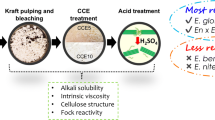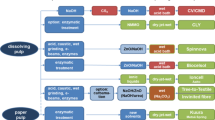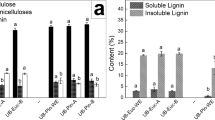Abstract
Aqueous-phase prehydrolysis followed by alkaline pulping is a viable process to produce wood-based dissolving pulps. However, detailed characterisation of the achievable pulp quality, performance and cellulose structure is yet lacking. In this study, the production of hemicellulose-lean birch soda-anthraquinone pulps after prehydrolysis under various intensities was investigated. Increasing prehydrolysis intensity resulted in pulps of higher purity but lower cellulose yield and degree of polymerisation. Higher cellulose yield by using sodium borohydride during pulping was achieved at the expense of reducing pulp purity. Cellulose crystallinity was similar in all pulps indicating simultaneous degradation of both crystalline and amorphous cellulose regions. Reinforced prehydrolysis seemingly increased the cellulose crystal size and the interfibrillar distances. Moderate intensity prehydrolysis (170 °C) resulted in a pulp well suited for viscose application, whereas reinforced prehydrolysis favoured the production of acceptable cellulose triacetate dope. The performance of the pulps in viscose and acetate applications was strongly related to the chemical and structural properties.





Similar content being viewed by others
References
Berggren R, Berthold F, Sjoholm E, Lindstrom M (2003) Improved methods for evaluating the molar mass distributions of cellulose in kraft pulp. J Appl Polym Sci 88:1170–1179. doi:10.1002/app.11767
BfR opinion No. 005/2013, 12 February 2013. http://www.bfr.bund.de/cm/349/bfr-removes-anthraquinone-from-its-list-of-recommandations-for-food-packaging.pdf
Borrega M, Nieminen K, Sixta H (2011a) Degradation kinetics of the main carbohydrates in birch wood during hot water extraction in a batch reactor at elevated temperatures. Bioresour Technol 102:10724–10732. doi:10.1016/j.biortech.2011.09.027
Borrega M, Nieminen K, Sixta H (2011b) Effects of hot water extraction in a batch reactor on the delignification of birch wood. BioResources 6:1890–1903
Borrega M, Tolonen LK, Bardot F, Testova L, Sixta H (2013) Potential of hot water extraction of birch wood to produce high-purity dissolving pulp after alkaline pulping. Bioresour Technol 135:665–671
Chunilall V, Bush T, Larsson PT, Iversen T, Kindness A (2010) A CP/MAS 13C-NMR study of cellulose fibril aggregation in eucalyptus dissolving pulps during drying and the correlation between aggregate dimensions and chemical reactivity. Holzforschung 64:693–698. doi:10.1515/hf.2010.097
Cross CF, Bevan EJ (1901) Cellulose xanthates. Ber Dtsch Chem Ges 34:1513–1520
El Seoud OA, Fidale LC, Ruiz N, D’Almeida MLO, Frollini E (2008) Cellulose swelling by protic solvents: which properties of the biopolymer and the solvent matter? Cellulose (Dordrecht, Neth) 15:371–392. doi:10.1007/s10570-007-9189-x
Fink H-P, Weigel P, Ganster J, Rihm R, Puls J, Sixta H, Parajo JC (2004) Evaluation of new organosolv dissolving pulps. Part II: structure and NMMO processability of the pulps. Cellulose (Dordrecht, Neth) 11:85–98. doi:10.1023/B:CELL.0000014779.93590.a0
Francis RC, Bolton TS, Abdoulmoumine N, Lavrykova N, Bose SK (2008) Positive and negative aspects of soda/anthraquinone pulping of hardwoods. Bioresour Technol 99(17):8453–8457. doi:10.1016/j.biortech.2008.02.055
Hinck JF, Casebier RL, Hamilton JK (1985) Dissolving pulp manufacture. In: Ingruber O, Kokurek J, Wong A (eds) Sulfite science and technology, vol 4. Pulp and Paper Manufacture, 3 edn. TAPPI, CPPA, Atlanta, pp 213–243
Hüpfl J, Zauner J (1966) Testing dissolving pulps by use of a laboratory-scale viscose plant. Papier (Paris) 20:125–132
Janson J (1970) Calculation of polysaccharide composition of wood and pulp. Pap Puu 52(323–326):328–329
Johansson MH (2008) Alkaline degradation of birch xylan in the light of its chemical structure. In: 2nd workshop on chemical pulping processes, Karlstad University
Koch G (2006) Raw material for pulp. In Wiley-VCH Verlag GmbH & Co. KGaA, pp 21–68. doi:10.1002/9783527619887.ch2
Kubikova J, Zemann A, Krkoska P, Bobleter O (1996) Hydrothermal pretreatment of wheat straw for the production of pulp and paper. Tappi J 79(7):163–169
Larsson PT, Wickholm K, Iversen T (1997) A CP/MAS carbon-13 NMR investigation of molecular ordering in celluloses. Carbohydr Res 302:19–25. doi:10.1016/s0008-6215(97)00130-4
Leppaenen K, Andersson S, Torkkeli M, Knaapila M, Kotelnikova N, Serimaa R (2009) Structure of cellulose and microcrystalline cellulose from various wood species, cotton and flax studied by X-ray scattering. Cellulose (Dordrecht, Neth) 16:999–1015. doi:10.1007/s10570-009-9298-9
Leschinsky M (2009) Water Prehydrolysis of Eucalyptus globulus. PhD thesis, University of Hamburg
Newman RH (1992) Solid-state carbon-13 NMR spectroscopy of multiphase biomaterials. ACS Symp Ser 489:311–319
Penttilä PA, Varnai A, Leppänen K, Peura M, Kallonen A, Jääskeläinen P, Lucenius J, Ruokolainen J, Siika-Aho M, Viikari L, Serimaa R (2010) Changes in submicrometer structure of enzymatically hydrolyzed microcrystalline cellulose. Biomacromolecules 11:1111–1117. doi:10.1021/bm1001119
Penttilä PA, Kilpeläinen P, Tolonen L, Suuronen J-P, Sixta H, Willför S, Serimaa R (2013) Effects of pressurized hot water extraction on the nanoscale structure of birch sawdust. Cellulose 20:2335–2347
Råmark H, Leavitt A (2012) Andritz’s new technology applied to dissolving pulp grades—a different approach. Paper presented at the 4rd Nordic Wood Biorefinery Conference, Helsinki, Finland
Rauhala T, King AWT, Zuckerstatter G, Suuronen S, Sixta H (2011) Effect of autohydrolysis on the lignin structure and the kinetics of delignification of birch wood. Nordic Pulp Pap Res J 26:386–391
Richter GA (1956) Some aspects of prehydrolysis pulping. Tappi 39:193–210
Rustemeyer P (ed) (2004) Cellulose acetates: properties and applications. (GAMA Workshop held in Heidelberg, Germany 29 September–1 October 2003.) [In: Macromol Symp, 2004; 208]. Wiley-VCH Verlag GmbH & Co. KGaA
Rydholm SA (1965) Pulping processes. Interscience Publishers, Wiley, London
Schild G, Sixta H (2011) Sulfur-free dissolving pulps and their application for viscose and lyocell. Cellulose (Dordrecht, Neth) 18:1113–1128. doi:10.1007/s10570-011-9532-0
Schild G, Sixta H, Testova L (2010) Multifunctional alkaline pulping, delignification and hemicellulose extraction. Cellul Chem Technol 44(1–3):35–45
Sixta H (2006) Pulp properties and applications. In: Handbook of Pulp, vol 2. Wiley-VCH Verlag GmbH & Co. KGaA, pp 1009–1067. doi:10.1002/9783527619887.ch11
Sixta H, Potthast A, Krotschek AW (2006) Chemical pulping processes. In: Sixta H (ed) Handbook of Pulp, vol 1. Wiley-VCH Verlag GmbH & Co, KGaA, pp 109–509
Sixta H, Iakovlev M, Testova L, Roselli A, Hummel M, Borrega M, van Heiningen A, Froschauer C, Schottenberger H (2013) Novel concepts of dissolving pulp production. Cellulose 20(4):1–15
Smiljanski S, Stankovic S (1974) Beech wood glucuronoxylan in the prehydrolysis kraft process. Cellul Chem Technol 8(3):283–294
Tappi (2011) Dissolving pulp gold rush in high gear. Paper 360° (September/October) 8–12
Testova L, Vilonen K, Pynnonen H, Tenkanen M, Sixta H (2009) Isolation of hemicelluloses from birch wood: distribution of wood components and preliminary trials in dehydration of hemicelluloses. Lenzing Ber 87:58–65
Testova L, Chong S-L, Tenkanen M, Sixta H (2011) Autohydrolysis of birch wood: 11th EWLP, Hamburg, Germany, August 16–19, 2010. Holzforschung 65(4):535–542. doi:10.1515/HF.2011.073
Testova L, Nieminen K, Penttila PA, Serimaa R, Potthast A, Sixta H (2014) Cellulose degradation in alkaline media upon acidic pretreatment and stabilisation. Carbohydr Polym 100:185–194. doi:10.1016/j.carbpol.2013.01.093
Treiber E, Rehnstrom J, Ameen C, Kolos F (1962) A miniature laboratory viscose “plant” for the testing of chemical pulps. Papier (Paris) 16:85–94
Wickholm K, Larsson PT, Iversen T (1998) Assignment of non-crystalline forms in cellulose I by CP/MAS carbon-13 NMR spectroscopy. Carbohydr Res 312:123–129. doi:10.1016/s0008-6215(98)00236-5
Wollboldt RP, Zuckerstaetter G, Weber HK, Larsson PT, Sixta H (2010) Accessibility, reactivity and supramolecular structure of E. globulus pulps with reduced xylan content. Wood Sci Technol 44:533–546. doi:10.1007/s00226-010-0370-2
Yoon S-H, van Heiningen A (2008) Kraft pulping and papermaking properties of hot-water pre-extracted loblolly pine in an integrated forest products biorefinery. Tappi J 7:22–27
Acknowledgments
The authors acknowledge Tekes—the Finnish Funding Agency for Technology and Innovation, FIBIC—Finnish Bioeconomy Cluster, BIOREGS—Doctoral Programme for Biomass Refining, Andritz Oy, Danisco Sweeteners Oy, Metsä Fibre Oy, Stora Enso Oyj and UPM for the financial support. Armin Stein and Solvay—Rhodia for the help in establishing the laboratory cellulose acetylation method.
Author information
Authors and Affiliations
Corresponding author
Rights and permissions
About this article
Cite this article
Testova, L., Borrega, M., Tolonen, L.K. et al. Dissolving-grade birch pulps produced under various prehydrolysis intensities: quality, structure and applications. Cellulose 21, 2007–2021 (2014). https://doi.org/10.1007/s10570-014-0182-x
Received:
Accepted:
Published:
Issue Date:
DOI: https://doi.org/10.1007/s10570-014-0182-x




